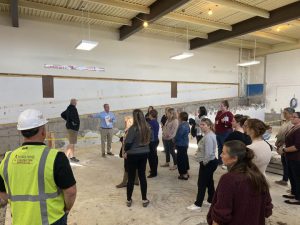
Construction on Phase 2 of the Capital Project approved by voters in May 2022 is well underway.
Phase 1 of the $25.9 million project, which included synthetic turf and lights on athletic fields, new tennis courts, and other improvements, was completed last year. Key components of Phase 2 of the project for the Elementary School include converting the current gym, cafeteria and kitchen area into a full-size gymnasium with a stage at one end. New bathrooms, including some with secure outdoor entrances/exits; renovated locker rooms; roof work and window replacements will also be completed.
The re-imagined spaces are intended to make not only the learning spaces better in the Elementary, but also improve the experiences of the greater school community as they attend special events.
While it is never ideal to undergo a large construction project while classes are in session, the limited amount of time when they are not in session, as well as the scope of this project necessitated that the work be done during the school year. Delays in the project in order to work around class schedules, also leaves the project susceptible to inflationary cost overruns.
The heavy work involved with the removal of concrete is nearing completion. The interior of parts of the building have been reduced to a basic framework and is being prepped for the transformative renovations.
Under the plans, the 1952 gym in the Elementary will be remodeled into a new library, while the current library space will be converted into the cafeteria/kitchen. Bathrooms with secure outdoor entrances/exits will be installed in the rear of the new cafeteria. Roof work is planned for both the Elementary wing and the Jr./Sr. High School.
“We appreciate the patience of our staff, students and their families. We understand this project has caused changes to our daily routine, but the end result will be worth it, as we create better learning spaces for our students and more inviting spaces for the greater school community,” Superintendent David M. Blanchard said. “In addition, the project will provide modernizations and energy efficiencies that will benefit our community for decades to come.”
The capital project is funded mostly through state aid. As with the other recent building projects, there would be no impact on the tax levy. For every dollar spent on the project, New York state will fund 86 cents. The remainder would come through an existing capital reserve fund.
Work on a separate Energy Performance Project that is also being funded through state aid and reserves is expected to begin soon. The key feature of that project is a 740-kilowatt solar field on an acre of vacant land behind the track.